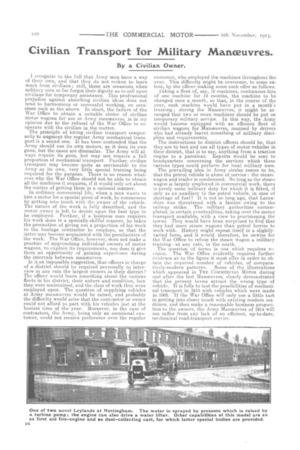Civilian Transport for Military Manceuvres.
Page 18

If you've noticed an error in this article please click here to report it so we can fix it.
By a Civilian Owner.
.1 recognize to the full that Army men have a way of their own,. and that they do not reckon to learn much from civilians ; still, there are occasions when military men so far forget their dignity as to call upon civilians for temporary assistance. This professional prejudice against absorbing civilian ideas does not tend to harmonious or successful working, on occasions such as the above. In short, the failure of the War Office to obtain a suitable choice of civilian motor wagons for use at Army manoeuvres, is in my opinion due to the refusal of the War Office to cooperate with the civilian in the matter.
The principle of hiring civilian transport temporarily to augment the regular Army mechanical transport is a sound one. It has been contended that the Army should use its own motors, as it does its own guns, but the cases are dissimilar. The Army will always require its guns, but may not require a full proportion of mechanical transport. Further, civilian transport .may become quite as serviceable to the Army as its own, very little special training being required for the purpose. There is no reason whatever why the War Office should not be able to obtain all the machines it requires, if it would only set about the matter of getting them in a rational manner.
In ordinary commercial life, when a man wants to hire a motor for a special piece of work, he commences by getting into touch with the owner of the vehicle. The nature of the work is fully described, and the motor owner is left to decide upon the best type to be employed. Further, if a business man requires his work done in a specially-skilful manner, he takes the precaution of giving out a proportion of his work to the haulage contractor he employs, so that the latter may become acquainted with the peculiarities of the work. The War Office, however, does not make a practice of approaching individual owners of motor wagons, to explain. its requirements, nor does it give them an opportunity of gaining experience during the intervals between rnanceuvres.
Is it an impossible suggestion, that officers in charge of a district should be required personally to interview at any rate the largest owners in their district ? The officer would learn something about the various fleets in his district, their nature and condition, how they were maintained, and the class of work they were employed upon. The question of supplying vehicles at Army manoeuvres would be raised, and probably the difficulty would arise that the contractor or owner could not afford to part with his vehicles just at the busiest time of the year.Moreover, in the case of contractors, the Army, being only an oaars sional customer, could not receive preference over the regular customer, who employed the machines throughout the year. This difficulty might be overcome, to some extent, by the officer making some such offer as follows. faking a fleet of, say, 12 machines, continuous hire of one machine for 12 months, the machine to be changed once a month, so that, in the course of the year,. each machine would have put in a month's training; during the Manceuvres, it might be arranged that two or more machines should be put on temporary military service. In this way, the Army would become equipped with an efficient fleet of civilian wagons for blanceuvres, manned by drivers who had already learnt something of military discipline and requirements.
The instructions to district officers should be, that they are to test and use all types of motor vehicles in their district, that is to say, anything from a traction engine to a parcelcar. Reports would be sent to headquarters concerning the services which these various types could perform for local military uses. The prevailing idea in Army circles seems to be, that the petrol vehicle is alone of service : the steam wagon and trailer is condemned. So long as the steam wagon is largely employed in commercial work, there is surely some military duty for which it is fitted, if only as an auxiliary to the petrol vehicle, in case of shortage of fuel? It is not so long ago, that Lancashire was threatened with a famine owing to the railway strike. The military authorities contemplated, in certain eventualities, taking over the motor transport available, with a view to provisioning the towns. They would have been surprised to find that they had more steam wagons than petrol lorries to work with. History might repeat itself in a slightlyvaried form, and it would, therefore, be unwise for the War Office to refuse the steam Wagon a military training--at any rate, in the north.
The question of terms is one which requires revision. The War Office evidently requires further evidence as to the figure it must offer in order to obtain the required number of vehicles, of compara tively-modern patterns. Some of the illustrations which appeared in THE COMMERCIAL MOTOR during and after the last Manceuvres, clearly demonstrated that the present terms attract the wrong type of vehicle. It is folly to test the possibilities of mechanical transport in 1913 with vehicles which were made in 1903. If the War Office will only use a little tact in getting into closer touch with existing modern machines, and then make a reasonable business proposition to the owners, the Army Manoeuvres of 1914 will not suffer from any lack of an efficient, up-to-date, mechanical road-transport service,
























